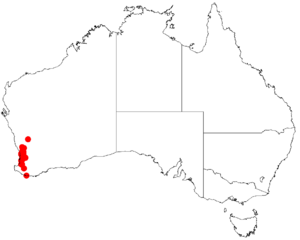Hook-leaved acacia facts for kids
Quick facts for kids Hook-leaved acacia |
|
|---|---|
| Scientific classification | |
| Genus: |
Acacia
|
| Species: |
oncinophylla
|
 |
|
| Occurrence data from AVH | |
The hook-leaved acacia (Acacia oncinophylla) is a cool shrub that belongs to the Acacia family. It's also known as Acacia oncinophylla. You can find it growing in parts of Western Australia.
Contents
What Does the Hook-Leaved Acacia Look Like?
This shrub usually grows to be about 0.5 to 3 metres (2 to 10 ft) tall. It has special bark that looks a bit like minni ritchi bark, which is flaky and reddish-brown. Its branches are flat and have ribs, and they can be smooth (this is called glabrous) or have a few hairs. Sometimes, they even have a white powdery coating!
Special Leaves Called Phyllodes
Instead of regular leaves, the hook-leaved acacia has something called phyllodes. These are like flattened leaf stems that do the job of leaves. They stay green all year round.
The phyllodes are long and narrow, or sometimes a bit wider at the top. They can be straight or slightly curved. They are smooth and can be flexible or a bit stiff. Each phyllode is about 4 to 13 cm (1.6 to 5.1 in) long and 1 to 6 mm (0.039 to 0.236 in) wide. They have a pointed tip and usually have three to seven raised lines (nerves) on each side.
Flowers and Seed Pods
The hook-leaved acacia blooms with bright yellow flowers from August to September. Its flowers grow in groups called inflorescences, which are like little spikes. These spikes are found in pairs where the phyllodes meet the stem (this spot is called the axil).
Each flower spike is about 11 to 25 mm (0.43 to 0.98 in) long and 5 to 6 mm (0.20 to 0.24 in) wide. They are packed with 50 to 97 golden-colored flowers!
After the flowers, the plant grows seed pods. These pods are velvety and can be golden or silver in color. They are long and straight or slightly curved, growing up to 6 cm (2.4 in) long and 5 to 6 mm (0.20 to 0.24 in) wide. Inside, you'll find shiny black seeds that are broadly oval-shaped, about 3 to 3.5 mm (0.12 to 0.14 in) long. Each seed has a small, fleshy attachment at its tip called an aril.
How Scientists Name and Classify Plants
The hook-leaved acacia was first officially described by a botanist named John Lindley in 1839. Botanists are scientists who study plants.
Sometimes, a plant species can have slightly different versions. These are called subspecies. For the hook-leaved acacia, there are two known subspecies:
- Acacia oncinophylla subsp. oncinophylla
- Acacia oncinophylla subsp. patulifolia
This plant is also quite similar to another acacia called Acacia fauntleroyi, which grows a bit further to the east.
Where Does the Hook-Leaved Acacia Grow?
The hook-leaved acacia is native to Western Australia. You can find it in the Swan Coastal Plain and South West regions. It likes to grow on hills and slopes.
It prefers soils that come from granitic rocks or laterite, which is a type of reddish soil. You can find it from places like Mogumber in the north, all the way down the Darling Range to areas around Wagerup in the south. It often grows as part of the Jarrah woodland communities.

